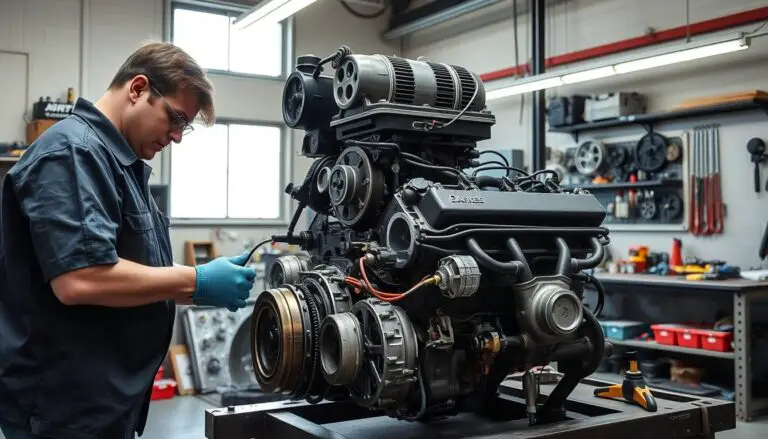The Research Octane Number (RON) serves as a pivotal metric in assessing a fuel’s octane rating, a factor of paramount importance for vehicular performance. In essence, RON quantifies a fuel’s resilience against engine knocking or pinging, a phenomenon that can lead to detrimental effects over time.
For the discerning car owner and aficionado, grasping the nuances of octane ratings is indispensable. These ratings span from 87 to 94, with higher values signifying fuel that exhibits a diminished propensity for pre-ignition under pressure. Standard fuel generally boasts an octane rating of approximately 87, whereas premium fuel ranges from 91 to 94.
Key Takeaways
- RON is a measure of a fuel’s resistance to engine knocking.
- Octane ratings range from 87 to 94.
- Higher octane ratings indicate fuel that is less likely to pre-ignite.
- Regular fuel typically has an octane rating of around 87.
- Premium fuel has an octane rating from 91 to 94.
What Does RON Mean in Fuel? Understanding Octane Ratings
The term Research Octane Number, or RON, is often discussed in the context of fuel, yet its true significance remains elusive. It quantifies the fuel’s capacity to withstand engine knocking or pinging, a phenomenon that can lead to long-term engine deterioration.
The Definition of Research Octane Number
The Research Octane Number is derived from a precise test procedure, wherein a fuel sample is subjected to a standardized engine under conditions of mild operation. This evaluation assesses the fuel’s knock resistance, with elevated ratings signifying enhanced resilience. The RON rating is paramount, as it enables consumers to select the appropriate fuel for their vehicles, thus ensuring peak performance and averting potential engine harm.

The History and Development of Octane Ratings
The genesis of octane ratings traces back to the early 20th century, a period marked by the advent of higher compression engines and the resultant engine knocking issue. The inception of the octane rating system occurred in the 1920s, with subsequent advancements leading to the inclusion of diverse testing methodologies, such as the Research Octane Number and the Motor Octane Number (MON). A comprehensive understanding of the history and development of octane ratings offers profound insights into the intricacies of fuel quality and engine performance.
The progression of octane ratings mirrors the relentless pursuit of enhancing fuel quality and engine efficiency. As engines evolved, the necessity for more precise and pertinent octane rating methodologies became apparent, prompting the establishment of various testing standards.
How Octane Ratings Are Measured
To fully appreciate the importance of octane ratings, one must explore the methodologies employed in their measurement. This process entails standardized testing to ascertain a fuel’s resistance to engine knocking or pinging. Such occurrences can lead to engine damage over time, making the understanding of these ratings critical.
The Science Behind RON Testing
The Research Octane Number (RON) serves as a widely accepted metric for determining fuel octane ratings. RON testing is conducted under mild operating conditions to evaluate a fuel’s performance. This evaluation involves comparing the fuel’s performance in a test engine against a mixture of iso-octane and n-heptane. The percentage of iso-octane in the mixture that matches the fuel’s performance is its RON.
Key aspects of RON testing include:
- Testing under mild engine conditions
- Comparison against iso-octane and n-heptane mixtures
- Assessment of fuel’s knock resistance
RON vs. MON: Different Testing Methods
Unlike RON testing, which is conducted under mild conditions, Motor Octane Number (MON) testing simulates high-speed driving conditions. MON is typically lower than RON for the same fuel, as it tests the fuel under more severe stress. Both RON and MON provide a comprehensive view of a fuel’s performance under different engine conditions.
For a detailed understanding of how different octane ratings are suited for various engine types, including those with a high compression ratio like 11:1, visit this resource.

The Anti-Knock Index (AKI) Used in the United States
In the United States, the Anti-Knock Index (AKI) is commonly used, which is the average of RON and MON. The AKI provides a balanced measure of a fuel’s performance under both low and high-speed conditions. For instance, if a fuel has a RON of 95 and a MON of 85, its AKI would be 90.
The AKI is significant because:
- It offers a straightforward measure for consumers to understand fuel quality.
- It helps in comparing different fuel types available in the market.
Understanding these testing methods and indices is crucial for both consumers and manufacturers. It ensures the right fuel is used for specific engine requirements, enhancing performance and reducing the risk of engine knock.
Common Octane Ratings and Their Applications
Fuel varieties, distinguished by their octane ratings, cater to diverse vehicular needs and performance levels. Regular, mid-grade, and premium fuels represent the spectrum, with racing fuels catering to the pinnacle of automotive engineering.
Regular (87), Mid-Grade (89), and Premium (91-93) Fuel Explained
Regular fuel, with an octane rating of 87, serves as the quintessential choice for the majority of passenger vehicles. It strikes a balance between performance and economy. Mid-grade fuel, rated at 89 octane, occupies the middle ground, appealing to drivers seeking a higher octane without the premium cost. Premium fuel, with ratings ranging from 91 to 93, is reserved for vehicles that necessitate the highest octane levels, typically those equipped with turbochargers or high-performance engines.
The octane rating is the pivotal factor distinguishing these fuel types. It directly influences their capacity to withstand engine knock or pinging. Higher octane fuels, thus, are more adept at handling engines with elevated compression ratios or those that benefit from turbocharging or supercharging.
Regional Variations in Octane Standards
Octane standards exhibit regional disparities. In the United States, the norm is 87 for regular, 89 for mid-grade, and 91-93 for premium. Yet, globally, octane ratings and nomenclature diverge. This knowledge is imperative for drivers traversing international borders or importing vehicles.
Racing Fuels and High-Performance Applications
Racing fuels constitute a distinct category, engineered for the high-octane engines prevalent in racing. These fuels boast octane ratings significantly surpassing those of standard fuels, crafted to deliver peak performance under extreme conditions. They are exclusively designed for racing environments, not for everyday driving.
Adopting the correct fuel type is paramount for achieving optimal vehicle performance and longevity. Utilizing a fuel with an inappropriately high or low octane rating can compromise performance, diminish fuel efficiency, or even precipitate engine damage.
How Octane Ratings Impact Modern Engines
Grasping the influence of octane ratings on contemporary engines is paramount for enhancing engine performance and longevity. Modern engines, replete with advanced technologies, necessitate specific fuel attributes to function optimally.
Engine Knock and Pre-ignition Explained
Engine knock, colloquially referred to as pinging or pinking, manifests when the fuel-air mixture within the engine ignites prematurely, preceding the spark plug’s firing. This premature ignition can lead to engine damage over time. Pre-ignition, a phenomenon akin to engine knock, occurs when the fuel-air mixture ignites before the spark plug fires, often due to localized hot spots within the engine. Both engine knock and pre-ignition can be alleviated by utilizing fuel with an appropriate octane rating.
Higher octane fuel exhibits greater resistance to engine knock and pre-ignition, rendering it ideal for high-performance engines or those with elevated compression ratios.
Matching Fuel Octane to Engine Compression Ratio
The compression ratio of an engine is a pivotal factor in determining the requisite octane rating of the fuel. Engines boasting higher compression ratios necessitate higher octane fuel to avert engine knock and pre-ignition. Utilizing fuel with an octane rating that is too low can precipitate a decline in engine performance and potentially cause damage.
Turbocharging, Direct Injection, and Octane Sensitivity
Contemporary engine technologies, such as turbocharging and direct injection, have heightened the sensitivity of engines to fuel octane rating. Turbocharging augments the air intake into the engine’s cylinders, elevating the risk of engine knock. Direct injection, which delivers fuel directly into the cylinders, also augments the risk of engine knock. As a consequence, engines equipped with these technologies frequently require higher octane fuel to operate efficiently.
Effects on Fuel Economy and Emissions
The selection of fuel octane rating can also influence fuel economy and emissions. While higher octane fuel does not inherently offer superior fuel economy, employing the correct octane rating for the engine can optimize performance and efficiency. Engines susceptible to engine knock or pre-ignition may generate more emissions if the incorrect fuel is employed.
Comparison of Fuel Types and Engine Performance
| Fuel Type | Octane Rating | Engine Performance |
|---|---|---|
| Regular | 87 | Suitable for most passenger vehicles |
| Mid-Grade | 89-90 | Offers a balance between price and performance |
| Premium | 91-93 | Recommended for high-performance or turbocharged engines |
Conclusion
The selection of appropriate fuel for your vehicle is paramount for achieving peak engine performance and efficiency. The Research Octane Number (RON) serves as a pivotal indicator of fuel quality. It elucidates that higher RON values signify enhanced resistance to engine knock or pinging.
The significance of RON is profound, as utilizing the correct octane rating for your vehicle can significantly enhance fuel efficiency, diminish emissions, and avert engine damage. Modern engines, notably those equipped with turbocharging and direct injection, necessitate specific octane ratings to function optimally.
By comprehending the importance of RON and selecting the appropriate fuel type, vehicle owners can guarantee their engines operate with utmost smoothness and efficiency. This knowledge is indispensable for preserving the overall health and performance of your vehicle.
FAQ
What does RON stand for in fuel octane ratings?
RON, an acronym for Research Octane Number, quantifies a fuel’s innate resistance to engine knock or pinging phenomena.
How is the Research Octane Number (RON) different from the Motor Octane Number (MON)?
Diverging in their methodologies, RON and MON serve as octane rating metrics, yet they are evaluated under disparate test conditions. Predominantly, RON is employed globally, whereas MON is concurrently utilized in certain jurisdictions to derive the Anti-Knock Index (AKI).
What is the Anti-Knock Index (AKI) used in the United States?
In the United States, the Anti-Knock Index (AKI) emerges as the octane rating standard, being the arithmetic mean of RON and MON.
What are the common octane ratings available at fueling stations?
Fueling stations typically offer Regular (87), Mid-Grade (89), and Premium (91-93) octane ratings, with regional variations influencing the exact offerings.
How do I know which octane rating is suitable for my vehicle?
To ascertain the appropriate octane rating for your vehicle, consult your owner’s manual, as it is contingent upon the engine’s compression ratio and other technical specifications.
Can using a higher octane fuel than recommended improve my vehicle’s performance?
Typically, employing a higher octane fuel than the recommended specification does not enhance performance. Notwithstanding, it may be advantageous for high-performance engines or those necessitating premium fuel.
What is engine knock or pinging, and how is it related to octane ratings?
Engine knock or pinging manifests as a knocking or pinging sound, indicative of premature ignition of the fuel-air mixture within the engine. Higher octane fuels exhibit greater resistance to this phenomenon.
Are there regional variations in octane standards?
Affirmative, octane standards exhibit regional disparities, with some nations adhering to RON, while others employ AKI or alternative ratings.
What are racing fuels, and how do they differ from standard fuels?
Racing fuels, tailored for high-performance applications, typically possess higher octane ratings than conventional fuels.
How do turbocharging and direct injection affect octane sensitivity?
Turbocharging and direct injection technologies can elevate the propensity for engine knock, necessitating a more judicious selection of octane rating for vehicles equipped with these innovations.


